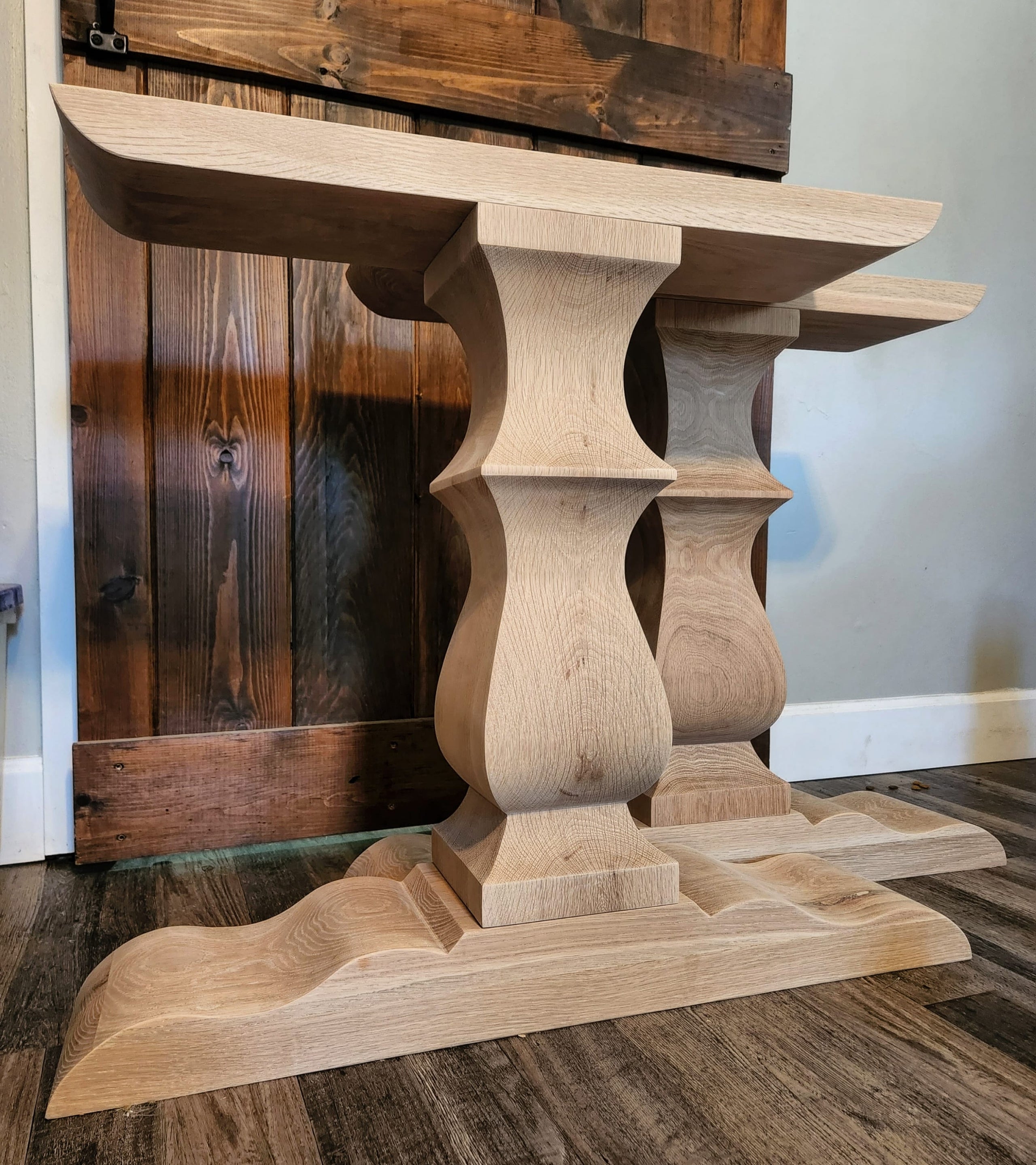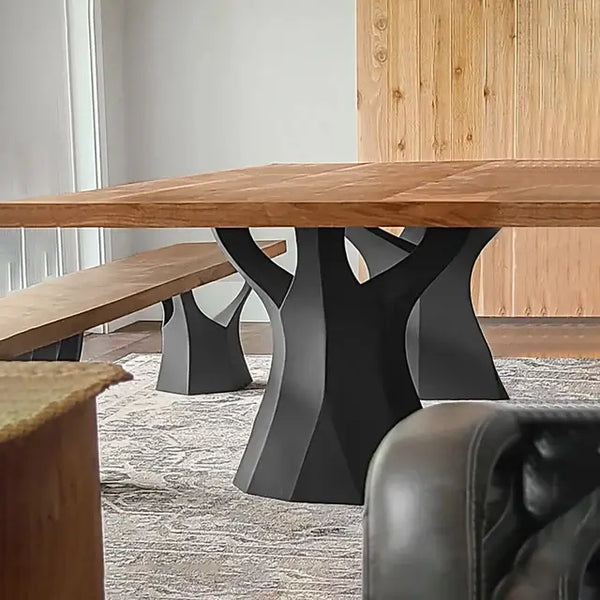Affordable and High-Quality Dining Room Table Legs for Every Budget
Affordable and High-Quality Dining Room Table Legs for Every Budget
Blog Article
From Conventional to Modern: Find the Perfect Dining-room Table Legs for Your Style
The option of dining-room table legs plays a crucial role in specifying the total personality of your room, linking the gap between typical workmanship and modern-day aesthetic appeals. While timeless styles such as cabriole and transformed legs stimulate a sense of ageless refinement, modern styles like hairpin and geometric choices offer a chance for striking aesthetic interest. Examining the right balance between these designs needs a nuanced understanding of your existing decor and personal taste. As you consider these elements, the concern remains: just how can you seamlessly incorporate these varied leg designs to develop an unified eating experience?
Comprehending Table Leg Styles
The range of eating area table leg styles can dramatically affect both the appearances and functionality of the area. Each leg design adds special sensible attributes and aesthetic aspects, satisfying varied design choices and use needs. Understanding these designs is essential for picking the appropriate eating table that straightens with your general interior decoration vision.
For circumstances, conical legs supply a clean, classic look that can improve a room's sophistication, while stand bases supply stability and make best use of legroom, making them suitable for smaller sized areas. Hairpin legs, a characteristic of mid-century contemporary layout, present an industrial panache, permitting an airy, open feeling. Trestle legs evoke rustic charm, providing robust support and a feeling of eternity.
Additionally, the option of products plays a considerable role. Wood legs can bring warmth and structure, whereas metal options usually communicate a sleek, contemporary vibe. Ultimately, understanding table leg designs is necessary for producing a natural dining area that shows personal style while guaranteeing usefulness and comfort. By attentively thinking about these aspects, you can improve both the practical and visual allure of your dining room.
Traditional Table Leg Options
When choosing dining-room table legs, typical choices frequently symbolize ageless elegance and craftsmanship. These styles show an abundant heritage and a dedication to top quality, making them suitable for those who appreciate classic aesthetic appeals.
Among the most legendary typical leg designs is the cabriole leg, identified by its elegant rounded form. This layout usually includes attractive carvings and is most generally located in Queen Anne and Chippendale furnishings. An additional prominent choice is the turned leg, which boasts a series of smooth, rounded shapes that provide a classic look while preserving stability.
Furthermore, the straight leg, while simple, offers a sturdy and basic structure that can blend seamlessly with a variety of tabletop designs. For those attracted to ornate outlining, claw-and-ball feet legs stimulate a feeling of majesty and can work as a magnificent focal factor in any kind of eating space.
Lastly, stand bases, although not strictly legs, supply an alternate traditional alternative that enables sufficient legroom and can be perfectly sculpted. Each of these conventional leg styles adds to the total ambiance of a dining space, weding feature with aesthetic allure.

Modern Table Leg Designs
Modern table leg designs use a diverse series of designs that highlight ingenious materials and clean lines. These layouts usually prioritize capability while functioning as striking prime focus within a dining room. Minimalist aesthetics are prevalent, with legs crafted from materials such as steel, glass, and engineered wood, which add to a airy and modern feel.
One prominent layout is the barrette leg, identified by its slim, conical structure that supplies security without frustrating the tabletop (dining room table legs). This design is usually found in mid-century contemporary furniture and can easily enhance different eating table forms. An additional trend is making use of geometric Visit Website shapes, where legs Website may handle asymmetrical or angular types, including aesthetic rate of interest and a touch of virtuosity

Mixing Designs for Special Rooms
Typically, home owners look for to produce special eating rooms that mirror their personal design by mixing different design components. This strategy permits the consolidation of diverse appearances, causing a harmonious yet unique atmosphere. As an example, coupling a rustic wood table with sleek, modern metal legs can develop a distinctive contrast that boosts the room's overall appeal.
Additionally, integrating vintage table legs with contemporary table tops can stimulate a sense read of background while keeping a modern perceptiveness. Such mixes not only showcase private preference however additionally motivate creativity, allowing home owners to curate a room that really feels both personal and inviting.
Color plays a critical role in this mixing process; choosing table legs that match or contrast with the existing shade scheme can improve aesthetic rate of interest. For instance, whitewashed legs can soften the boldness of a dark table surface, creating a balanced visual.
Tips for Choosing the Right Legs
Choosing the right table legs is crucial for achieving both capability and aesthetic charm in your eating area. Begin by taking into consideration the total design of your room. Standard setups take advantage of legs that feature detailed carvings or turned styles, while contemporary spaces might call for smooth, minimal designs.
Following, assess the height and security of the legs. dining room table legs. Basic eating tables vary in between 28 to 30 inches in height, so make sure the legs enhance this dimension for convenience. Additionally, robust materials, such as wood or steel, can improve stability and durability
Review the leg shape as well-- alternatives include right, tapered, or stand styles. Straight legs supply a traditional look, while tapered legs can add a touch of beauty. Pedestal bases provide adequate legroom and are ideal for smaller sized spaces.
Conclusion
In summary, picking the suitable dining-room table legs requires mindful factor to consider of both contemporary and traditional designs. Typical alternatives such as cabriole and transformed legs supply classic elegance, while modern-day layouts like hairpin and geometric shapes provide a modern touch. By integrating leg design, elevation, and material with the general decor, a natural and welcoming environment can be achieved. Inevitably, the picked table legs must show the preferred aesthetic, enhancing the eating experience within the space.
The range of eating space table leg styles can dramatically influence both the looks and functionality of the room. Eventually, recognizing table leg designs is crucial for creating a natural dining area that mirrors individual style while guaranteeing usefulness and comfort.One of the most famous traditional leg designs is the cabriole leg, defined by its graceful rounded form. Straight legs offer a traditional appearance, while conical legs can add a touch of style.In summary, selecting the excellent eating space table legs needs careful consideration of both typical and modern-day designs.
Report this page